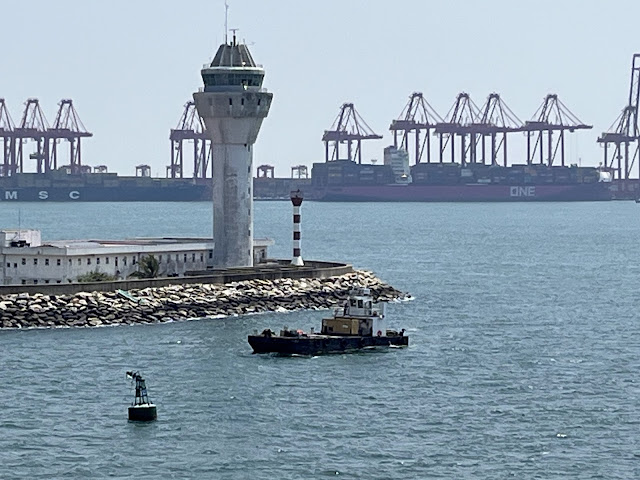March 9, 10
Ayubowan ~ May you live long!
We visited India in 2018, so I expected Sri Lanka to be an island sized version of the subcontinent. During the last ice age when the sea levels were lower, it did used to be attached to the mainland by a land bridge and there are myriad little islands dotting the sea between Sri Lanka and India so at one point there is only 32 kilometers between the two countries.
 |
| The Colombo port was dotted with these light houses along the jettee. One of them was a ship's equivalent to a VOR, radio beacon system used by private pilots before GPS made them obsolete. |
We had originally booked an evening at a special venue for a Sri Lankan dinner and traditional dance show, but it was unfortunately cancelled by the provider. However, we were greeted by a dance troup and a really excellent drumline at the pier.
 |
| The sharp shadows in this photo let you know just how intense the sun is in this part of the world! |
While our friends on board were taking their lives in their hands, riding tuk-tuks through the crazy traffic of Colombo, we opted for a visit to a tea plantation in the highlands. We were ready to get out of Dodge and see some of the country beyond the urban scenes.
 |
| Lush & heavy with verdant growth. The air was fresh and oxygen rich with the breath of green growing things! |
 |
| This tapper will score 300 trees every day and collect the latex in a small cup nailed to the tree trunk. Trees are tapped 10 months out of the year, then allowed a 2 month rest. |
The Rayigam Estate produces rubber and tea and employs hundreds of people, men and women and what looked to me to be multi-generational families. The older women we saw plucking the tea leaves with what looked like a headdress, but turned out to be a bag they dropped the leaves into, would which eventually hold 20-25 kilos per load. It looked like a very heavy job.
 |
| A goat cavorting on the stone fence surrounding the Hindu temple on the grounds. There was also a Buddhist temple for the workers. |
 |
| Cannon Ball Blossoms--the fruit that develops actually looks like cannon balls! |
After touring the factory, we were taken to the home of the tea estate's manager and served tea and cake in the lovely tropical garden surrounding the home. Please check the DH's montage for more pictures of this area. I could so see myself living here... if I didn't already live in a place I love!
One last observation. I haven't been in any American commercial ports. We usually sale out of terminals reserved for cruise ships and only see the workings of our ports in passing. But in Asia we have been docked alongside thousands of container ships and have been able to watch first hand the automation and clockwork precision that goes into loading and unloading freight. Singapore is building a new port, larger than their current one, which will be fully automated and run by AI.
I wonder what our longshoremen will have to say about that when it becomes evident we may need to innovate and update to stay competitive in the world...
And not it'll affect not just how we do transportation of goods. Lots of industries will be affected. I feel like we are at a flexion point when how we do things will change in the same magnitude of the way it changed during the Industrial Revolution. Or when computers ushered in the Information Age.
I hope we'll be ready.



A very interesting day, with a lot of variety. I worked in LA/Long Beach port in the early 1980's and it was fascinating! Still love watching the loading and unloading. As you say, lots of changes to come.
ReplyDeleteAll our days are so full of rich experiences. Feeling very blessed.
Delete